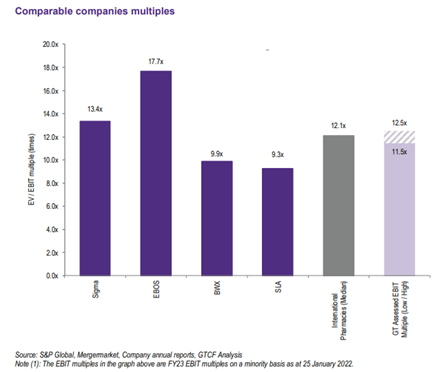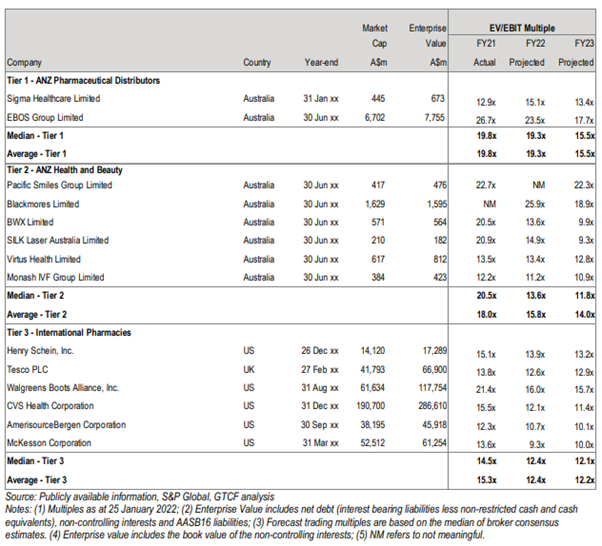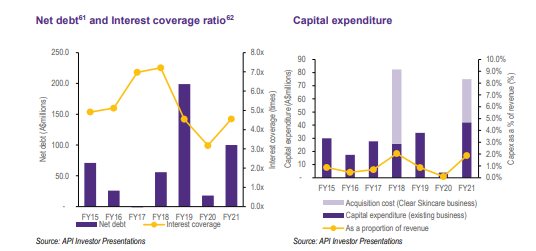Why Wesfarmers should lift its offer for API
A long-awaited development in the battle for control of Australian Pharmaceutical Industries Limited (ASX: API) occurred recently; the release of the scheme booklet. Within, an Independent Expert’s Report by Grant Thornton (GT) put the value of API between $1.48 and $1.78 per share. As Wesfarmer’s offer of $1.55 per share was within this range, albeit far closer to the low end than the top, the deal was rubber-stamped as “Fair and Reasonable”.
We’re less convinced.
In the context of multiple offers for a business, and a valuation towards the low end of the range provided by an Independent Expert, a focus for us is to drill down into the assumptions and methodology used to determine that valuation range. Coming out of that analysis, a few minor (and, in our opinion, reasonable) tweaks to various assumptions would see Wesfarmer’s current offer quietly slip outside the range and lose the coveted “Fair and Reasonable” declaration.
For us, it boiled down to three key components of the equity value calculation – the normalised EBIT, the applicable multiple, and the net debt and other deductions from the enterprise value.
The normalised EBIT
The impact of COVID on recent financial results has made this a little more complicated. GT has used $90 million - $95 million in their range.
Having delivered $32 million in underlying EBIT in 1H21, API guided to $75 milliion for the full year, or $43 million in the second half on the back of positive like for like sales growth at Priceline and double-digit growth in Clear Skincare. However, snap lockdowns towards the end of the financial year saw stores shut and the EBIT result come in at $70.1 million.
The underlying number excludes the costs of various initiatives to streamline operations and improve returns. Combined, the Pfizer distribution agreement, the Marsden Distribution Centre, Priceline network rationalisation, and closure of the New Zealand manufacturing plant are all expected to add as much as $20.4m in EBIT improvements by FY23.
Added to FY21’s result, it’s easy to see how we reach a $90m run rate, or $95m had API not been impacted by lockdowns in the last few months of the year.

It’s also substantially in line with the EBIT figures achieved in FY18 and FY19 prior to the onset of COVID, albeit the historical results evidently did not benefit from the recent initiatives.
GT’s normalised EBIT figure doesn’t seem unreasonable to us, but we’d argue it would lie towards the top end of that range due to the impact of the lockdowns on FY21 numbers - Priceline stores were forcibly closed for 41% of the available trading days and 58% for Clear Skincare. API’s 2H21 EBIT would have been $43 million, and perhaps a better representation of unrestricted business operations. Annualise that figure and it’s not a stretch to say $95 million is the closer number with cost out initiatives baked in.
The multiple
This is one of the biggest drivers of varying valuations, and often the most subjective. GT used an 11.5x multiple in the low case and 12.5x in the high case, in reference to what it considers the most comparable companies.

Sigma Healthcare (ASX: SIG) is undoubtedly the closest comparable, and there’s a lot of overlap with EBOS (NZX: EBO). Silk Laser (ASX: SLA) is an adequate comp for API’s Clear Skincare segment, but Clear Skincare makes up a small fraction of total group revenue and gross profit (~10%).
BWX Limited (ASX: BWX) is a consumer-facing manufacturer of skincare products, and its inclusion as a comparison is based on the premise Clear Skincare also sells complementary health and beauty products. For the most part, API is a pharmacy wholesaler as well as a health and beauty retailer of third party products. They are different business models with different risk profiles, as BWX's most recent 1H22 results clearly demonstrate. Its comparability is marginal at best.
International pharmacies as a group are shown at a 12.1x multiple, yet it’s a large generalisation in the context of API’s specific market structure and local geographic monopolies. BWX and Silk Laser are taken from a composite of second-tier comparables, but both are well below both the median and average multiples of the group despite their minor similarities to API.

The biggest question for us is why the closest peer, Sigma, enjoys a higher undisturbed multiple than what API shareholders are currently offered inclusive of a premium for control.
By GT’s own admission, API enjoys more streamlined operations with higher EBIT margins, higher ROE, quicker cash conversion, and is closer to monetising strategic initiatives. All attributes of a comparatively higher quality business. In much the same way that EBOS’ higher multiple is argued to be justified through comparatively higher EBIT margins, ROE, diversification of revenue streams, and scale, it appears API was not offered the same courtesy.
The rationale for SIG’s deserving of a higher multiple is apparently down to three reasons.
1. Sigma management has guided to $95-$100m EBITDA in FY23 which is significantly higher than the current consensus figure of $81.6m used.
Sigma’s FY22 numbers were recently downgraded from 5% growth on the prior corresponding period to negative 10%. There’s now far greater pressure on FY23 performance to hit the numbers, and likely a large factor as to why current consensus is below management targets. . Even GT acknowledge that the management target “remains unproven and appears challenging”.
2. Sigma as a pure-play pharmacy retailer and wholesaler is not exposed to the competitive and volatile retail environment.
Priceline’s like for like sales have remained flat for several financial years, and the Clear Skincare segment provides optionality for better growth prospects - 49% of clinics have been operational for less than the 2.5 years required to become cash flow positive and therefore understate the current earnings profile, and the Australian market for facial injectables is expected to grow at a CAGR of 26.3% through to 2028.
3. Sigma has seen strong top line growth while API hasn’t.
API has seen low single-digit top-line performance from the wholesale business over the last few years but has been impacted by lockdowns on the retail side of operations.
Various YTD trading updates for each business segment are given in the scheme booklet. Pharmacy distribution has been above budget, Priceline register sales have been higher than forecast and Clear Skincare cash sales are substantially exceeding pcp.
Is it right that API is penalised for this given normalised trading conditions don’t typically involve lockdowns and the business is clearly showing strength in their absence?
It’s subjective of course, but to us, the arguments aren’t compelling enough for API to warrant a lower multiple inclusive of a premium for control. At a minimum, we would argue a comparable multiple to Sigma as "Fair and Reasonable."
Net debt
Net debt in GT’s calculation totals $275.4m inclusive of lease liabilities.

The net debt position of $100m is somewhat flattering to API as the average gross debt totalled $173.3m throughout FY21. Taking the average gross debt net of cash would lower the equity value of API (as net debt increases to $309m), but GT has not done this and instead used year-end totals.
The same methodology has been equally applied to the analysis of Sigma. Sigma expected net debt to peak around $130m in December 2021 (before the impacts of $25-$30m in recently flagged one-off operating costs), which again is higher than the year-end figure of $82m used in the EBIT multiple applicable for comparative valuation.
Using Sigma’s peak debt instead would lift the EV/EBIT multiple to 14.8x. If the argument is to be made that API’s net debt figure should be more conservative (and reflect average gross debt throughout the period), it would not be logical to adjust the figure higher without an offsetting increase to the EV/EBIT multiple applied.
In API's defence, however, the net debt position comes on the back of significant capital expenditure throughout FY21, reflecting a further $32.5m payment for the Clear Skincare Clinics business and $23.3 million spend on Marsden Park. The future earnings impact of the Marsden Park spend is captured in FY23 EBITDA assumptions, but arguably the same cannot be said for the Clear Skincare earnings. The increase in debt marking down equity value without the corresponding earnings being factored in (in our view) is a bit harsh.

The substantial anomaly of the FY19 net debt position was due to the acquisition of an $86m stake in Sigma subsequently unwound in FY20. Outside of that, the current net debt position is higher than the average levels observed in recent financial years.
Turning to lease liabilities, don’t we all just love AASB 16.
It’s worth pointing out the difference in lease accounting between Sigma and API. API’s incremental borrowing rate is 2.91%, and SIG’s is 4.55% as at the end of the most recent respective financial years. SIG’s higher borrowing rate means lease liabilities are discounted at a higher rate resulting in a lower present value on the balance sheet. It also means that Sigma expenses a higher portion of its lease payments below the EBIT line.
With the lower incremental borrowing rate, API reports a higher carrying value of lease liabilities and expenses a higher portion of lease payments above the EBIT line.
Lease liabilities are also ~17% of the total enterprise value against an incremental borrowing rate of 2.91%. The valuation question is a very different equation on a pre-AASB 16 basis, but that's no longer the world we live in.
Still, it's all worth considering in the context of EV/EBIT multiples.
Subjective vs objective
Valuation is often subjective, though, and we are aware that our interpretation is not guaranteed to be the correct one. But we are evidently not alone in thinking there might be more value to be had, with API receiving non-binding offers from both Sigma and Woolworths. Both offers have since been withdrawn, but we feel it is largely a function Wesfarmers' foothold on the register more than a specific API valuation issue. The 19.3% stake held by Wesfarmers is a large deterrent to any alternative offer being tabled, let alone succeeding.
Sigma’s offer of an upfront $1.57 in value also flagged as much $45m in potential synergies that both bidder and target would share in (almost) equally as a combined entity. Based on splits, it could have been worth as much as an extra $0.055 in recurring earnings. Woolworths came in at the top end of GT’s range with a $1.75 indicative cash offer but withdrew citing an inability to “validate the financial returns it requires”.
In both instances, and before either rival offer was withdrawn, Wesfarmers made it unequivocally clear that its 19.3% stake would not support an offer that wasn’t theirs. It made securing a scheme vote majority of 75% much more difficult to complete, and a takeover offer structure would be prevented from hitting the magic 90% compulsory acquisition threshold. The inability for either rival bidder to effectively gain 100% control over API likely limited the ability to realise assumed synergies or rip out the unnecessary corporate costs required to justify such a premium for control.
Undoubtedly, Wesfarmer’s strategy to take a 19.3% stake and see off rival bidders is a deft touch in an auction process but doesn’t necessarily do enough to endear a suitor to shareholders hoping to maximise the value of their holdings.
A final point. At the current $1.55 cash offer, and on the assumption Wesfarmers successfully acquires API, any manager looking to retain their exposure to the sector might look to roll their proceeds into either Sigma or EBOS as the closest comps.
EBOS is facing execution risk after its recent, chunky acquisition of LifeHealthcare. Sigma is still investing to achieve their FY23 targets, and recently downgraded FY22 guidance.
API is undoubtedly facing its own execution risks, but both Sigma and EBOS trade at higher multiples undisturbed compared to what is offered for API inclusive a premium for control.
It is not immediately apparent to us that the alternative is better than the status quo.
As a bidder, the onus is on Wesfarmers to make their offer attractive enough for shareholders to hand over ownership.
In the context of everything discussed above, is it enough?

Never miss an insight
Enjoy this wire? Hit the ‘like’ button to let us know. Stay up to date with my content by hitting the ‘follow’ button below and you’ll be notified every time I post a wire.
Not already a Livewire member? Sign up today to get free access to investment ideas and strategies from Australia’s leading investors.
4 stocks mentioned

